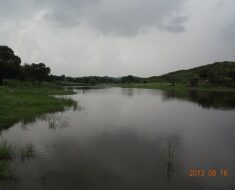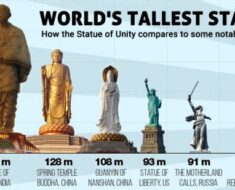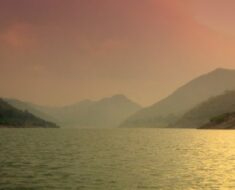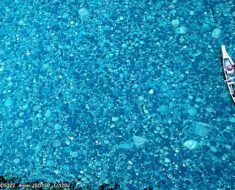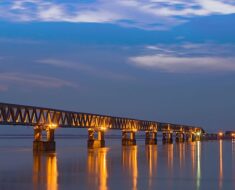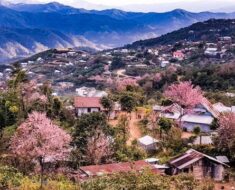India is an enormous and very vast country full of incredible and mindblowing places, monuments, festivals, places, etc. India is blessed with many diverse natural resources from mountains, rivers, lakes, forests, caves, etc.
And obviously man-made marvels from largest forts, tallest towers, biggest railways network, longest tunnels, bridges, highways, etc.
Here is the list of known and unknown incredible facts and superlatives about the longest, largest, highest, and tallest in India.
Largest in India
1. Which is the Largest National Park in India?

Hemis National Park is the largest Nation Park in India. It is situated in the Ladakh Union Territory, India.
Hemis National Park was founded in 1981 by protecting the Rumbak and Markha catchment areas.
It has been named after the Hemis Monastery which was founded in 1630 by Lama Tagstang.
When it was founded it has an area of 600km2 (230 sq mi). In 1990 its area was increased to 4,400 km2 (1,700 sq mi).
Hemis national park is the perfect place to experience and admire breathtaking landscapes of mountains, flatlands, and cold deserts.
The National Park is home to 16 mammal species and 73 bird species, recorded so far.
Snow leopards, the Tibetan wolf, the Eurasian brown bear, the red fox, Argali (Great Tibetan Sheep), Bharal (Blue Sheep), Shapu (Ladakhi Urial), the Himalayan marmot, mountain weasel, and the Himalayan mouse hare are present in Hemis.
Read More: Largest National Park in India – Hemis National Park
2. Which state has the Largest Forest Cover in India?
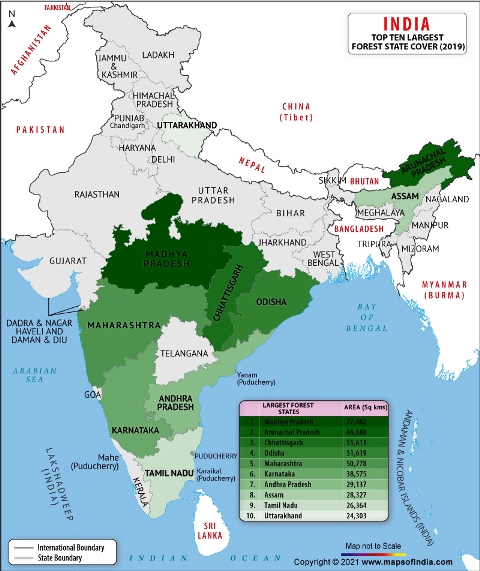
Madhya Pradesh has the Largest Forest Cover in India followed by Arunachal Pradesh, Chhattisgarh, Odisha, and Maharashtra.
In terms of forest cover as a percentage of total geographical area, the top five States are Mizoram (84.53%), Arunachal Pradesh (79.33%), Meghalaya (76.00%), Manipur (74.34%), and Nagaland (73.90%).
India’s overall forest and tree area is 80.9 million hectares, or 24.62 % of its geographic region, as per the India State of Forest Report 2021.
The forest area has increased by 1,540 square kilometers and tree cover has increased by 721 square kilometers in comparison to the previous report, ISFR 2021
3. Where is the Largest Zoo in India?
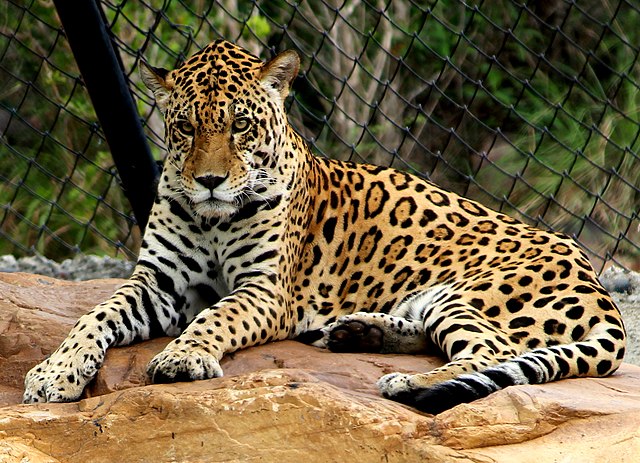
Sri Venkateswara Zoological Park is the largest zoo park in India. It is located in Tirupati, Andhra Pradesh.
It was established on 29 September 1987 and covers an area of 22.39 square kilometers.
Sri Venkateswara Zoological Park is also the largest zoological park in Asia.
It is followed by Arignar Anna Zoological Park or Vandalur Zoo in Chennai, Tamil Nadu, and Nandankanan Zoological Park in Bhubaneswar, Odisha.
The Thiruvananthapuram Zoo in Kerala is the oldest zoo in India. It is also the oldest in Asia.
The zoo and park were opened in 1859 and the museum was opened as early as September 1857.
HH Swathi Thirunal Rama Varma the ruler of Travancore was the visionary behind the establishment of the Thiruvananthapuram Museum and Zoo.
4. Which is the Largest Lake in India?
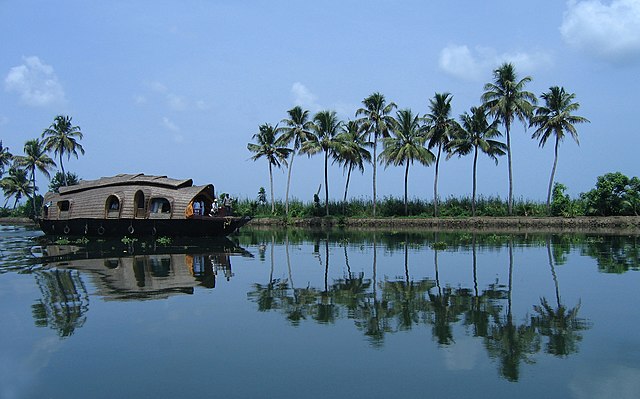
The Vembanad Lake also known as Vembanadu is the largest lake in India. It is situated in Kerala and has an area of 2033 square kilometers.
It has the second largest wetlands after the Sunderbans in West Bengal.
The Vembanad lake has a length of is 96.5 km making it the longest lake in the country also.
It spans many districts of Kerala and is known as Vembanadu Lake in Kottayam, Vaikom, Changanssery Punnamada Lake in Alappuzha, Punnappra, Kuttanadu, and Kochi Lake in Kochi.
Read More: Largest Lake in India – The Vembanad Lake
5. What is the Largest River Island in India?
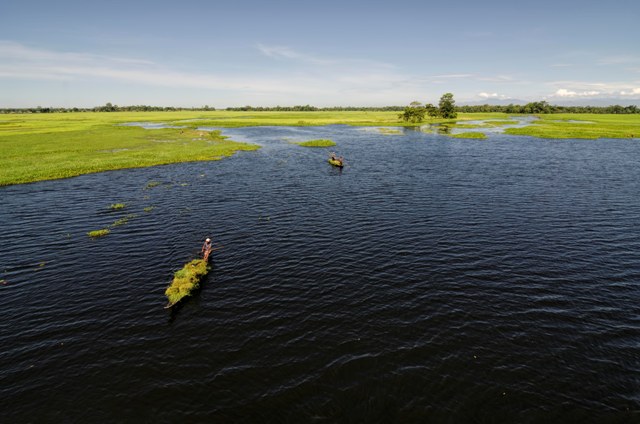
Majuli is the largest river island in India located in the Brahmaputra River in Assam.
It had an area of 1,255 square kilometers (485 sq mi) but lost significant area due to erosion.
Majuli has shrunk as the river surroundings have grown and in 2014 it had an area of 352 square kilometers (136 sq mi). It became the first island to be made a district in India in 2016.
The island is formed by the Brahmaputra River in the south and the Kherkutia Xuti and the Subansiri River in the north.
Majuli island is accessible by ferries from the city of Jorhat.
It was formed due to a change in course by the river Brahmaputra and its tributaries, mainly the Lohit.
It is around 345 kilometers from Guwahati and is the abode of the Assamese neo-Vaishnavite culture.
Majuli is in the UNESCO Tentative List for nomination as a World Heritage Site since 2004.
Read More: Deepest River in India – The Brahmaputra
6. Which is the Largest Wetland in India?
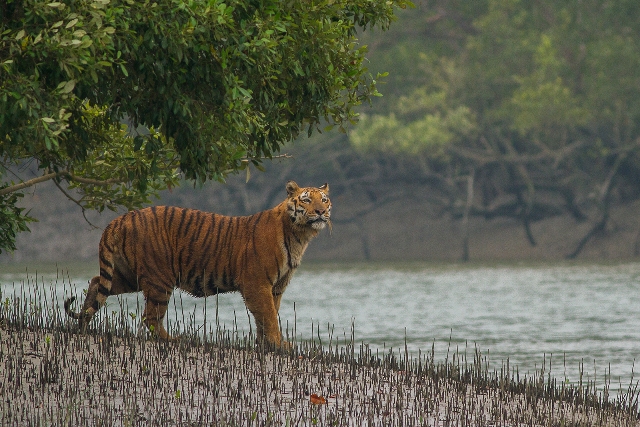
The Sundarbans are the Largest Wetland in India. It is formed by the confluence of the Padma (the Ganga in India), Brahmaputra, and Meghna Rivers in the Bay of Bengal.
Its area spans from the Baleswar River in Bangladesh, Khulna to the Hooghly River in India, West Bengal.
It is located within the largest mangrove forest in the world.
The Indian Sundarban, covering the southwesternmost part of the delta, constitutes over 60% of the country’s total mangrove forest area and includes 90% of Indian mangrove species.
Sundarbans National Park was declared a UNESCO World Heritage Site in 1987.
It has been designated as a Ramsar site since 2019.
7. Which is the Largest Delta in India?
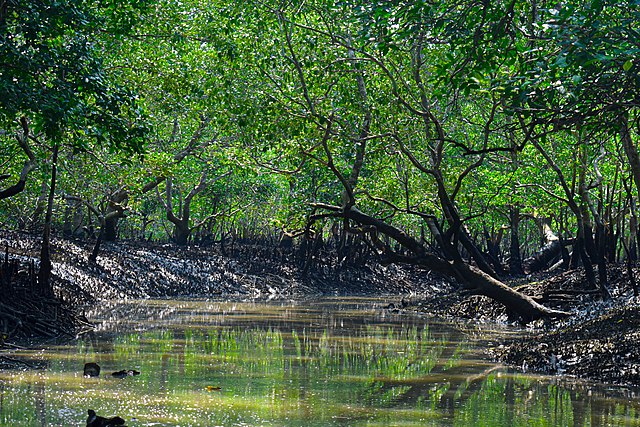
The Ganges Delta is the largest delta in India. It is also known as the Sundarbans Delta or the Bengal Delta.
The Sundarbans Delta is the also world’s largest river delta. It stretches from the Hooghly River east as far as the Meghna River and mostly lies in Bangladesh and India
The Ganges delta is also one of the most fertile regions in the world, thus nickname the Green Delta.
It has the shape of a triangle and is considered an arc-shaped delta that covers more than 105,000 km2 (41,000 sq mi).
8. Which is the largest Artificial Island in India?
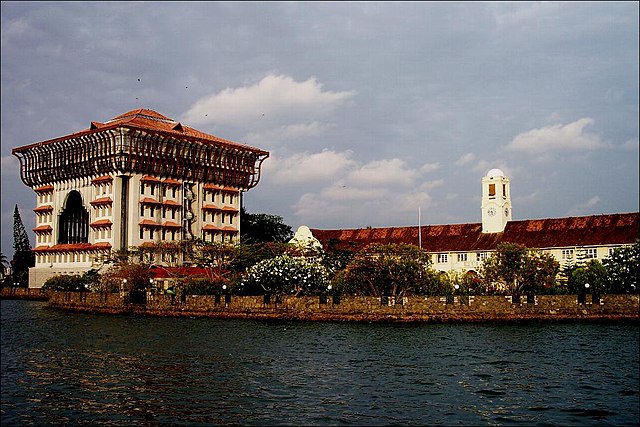
Willingdon Island is the largest artificial island in India. It is in the city of Kochi, Kerala.
Most of the present Willingdon Island was claimed from the Lake of Kochi by filling in dredged soil around a previously existing natural island.
The idea of developing a new port in Kochi was first felt by Sir Robert Bristow. He was appointed by Lord Willingdon the then Governor of Madras Presidency to create a new modern port.
The island was created during the construction of a modern port in 1936 and was completed in 1939. Sir Robert Bristow owned the first building on the island
Willingdon Island is significant as the home for the Port of Kochi as well as the Kochi Naval Base, the Southern Naval Command of the Indian Navy, Plant Quarantine Station, Customs House Cochin, and Central Institute of Fisheries Technology, a constituent unit of the Indian Council of Agricultural Research.
9. Which is the Largest Dam in India?
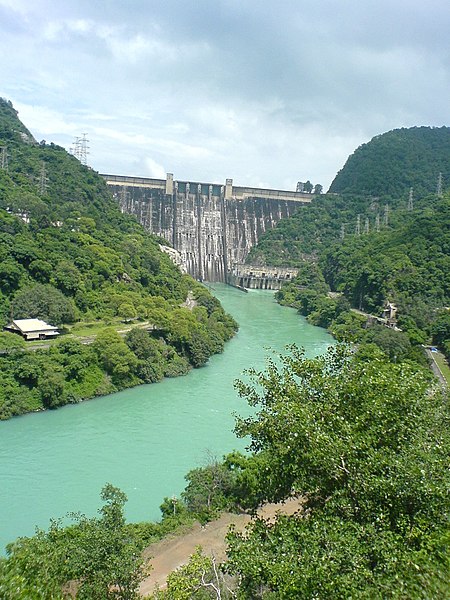
The Bhakra Nangal Dam is the largest dam in India. It is located in the state of Himachal Pradesh and Punjab.
Situated on the Sutlej river it is the largest dam in India having a height of 225 meters. It also holds the second position in the largest dams all over Asia.
The Bhakra Nangal Dam has the third largest reservoir in India in terms of quantity of water,
The first is the Indira Sagar dam in Madhya Pradesh and the second Nagarjunasagar Dam in Andhra Pradesh and Telangana
Read More: Shortest River in India – The Arvari River
10. Which is the Largest Solar Park in India?
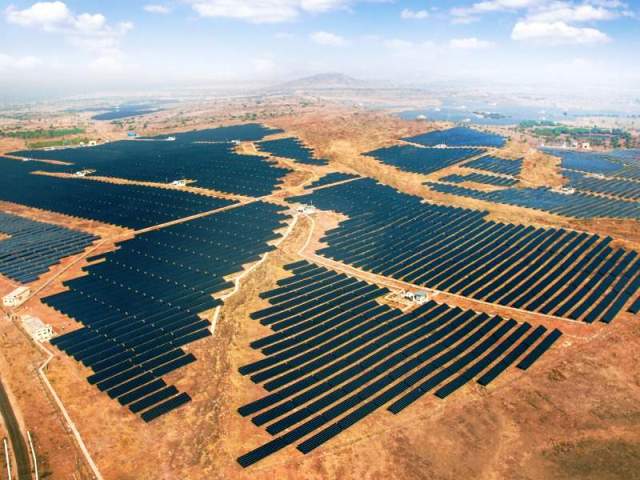
Bhadla Solar Park is the largest solar park in India and in the world as well. It is spread over a total area of 5,700 hectares (14,000 acres) in Bhadla, Jodhpur, Rajasthan.
At its full operational capacity, the Bhadla Solar Park became the largest fully commissioned PV project in the world at 2,245 MW.
Pavagada Solar Park solar park stands in the second position in India, covering an area of 13,000 acres in Pavagada taluk, Tumkur district, Karnataka.
It was completed in 2019 and the solar park has a capacity of 2,050 MW. (Link)
11. Which is the Largest Windmill Farm in India?
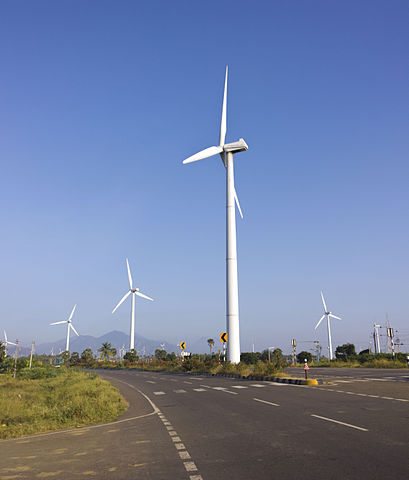
Muppandal Wind Farm is the Largest Windmill Farm in India. Located in Kanyakumari, Tamil Nadu, the farm has a capacity of 1500MW
Developed by Tamil Nadu Energy Development Agency It has an installed capacity is 1,500 MW, which makes it the 3rd-largest operational onshore wind farm in the world.
The Jaisalmer Wind Park is India’s second-largest and globally the fourth-largest operational onshore wind farm. It is located in the Jaisalmer district of Rajasthan
| Wind Power Plant | Megawatt (MW) | Location |
| Muppandal Wind Farm | 1500 | Tamil Nadu, Kanyakumari |
| Jaisalmer Wind Park | 1064 | Rajasthan, Jaisalmer |
| Brahmanvel Wind Farm | 528 | Maharashtra, Dhule |
| Dhalgaon Wind Farm | 278 | Maharashtra, Sangli |
| Vankusawade Wind Park | 259 | Maharashtra, Satara District. |
| Vaspet | 144 | Maharashtra, Vaspet |
| Tuljapur | 126 | Maharashtra, Osmanabad |
| Beluguppa Wind Park | 100.8 | Beluguppa, Andhra Pradesh |
| Mamatkheda Wind Park | 100.5 | Madhya Pradesh, Mamatkheda |
| Anantapur Wind Park | 100 | Andhra Pradesh, Nimbagallu |
12. Which is the Largest Hindu Temple in India?

Sri Ranganathaswamy Temple of Tamil Nadu is the largest Hindu temple in India.
It is a Hindu temple dedicated to Lord Ranganatha located in Srirangam, Tiruchirapalli, Tamil Nadu.
The temple occupies an area of 155 acres (63 ha) with 81 shrines, 21 towers, 39 pavilions, and many water tanks integrated into the complex making it the world’s largest functioning Hindu temple
Sri Ranganathaswamy Temple is constructed in the Hindu architectural style. The temple is among 108 Divya Desams dedicated to the god Vishnu.
The temple is enclosed by seven concentric walls called Prakarams which have a total length of 32,592 feet or over six miles.
Read More: Largest Hindu Temple in India – Sri Ranganatha Swamy Temple
13. Where is the Largest Temple Tank in India?

Haridra Nadhi is the largest temple tank in India and also the largest tank among all of the Hindu temples.
The Haridra Nadhi temple tank belongs to Rajagopalaswamy Temple, Mannargudi, Thiruvarur, Tamil Nadu. The temple is called Dakshina Dwarka (Southern Dwarka) along with Guruvayoor by Hindus.
The Rajagopalaswamy temple is a Vaishnava temple of the main god Rajagopalaswamy (Krishna).
The Haridra Nadhi tank is at the entrance of the shrine where rainwater is collected. It was constructed by Kulothunga Chola I. And later renovated by the Later Cholas and the Thanjavur Nayaks.
Read More: Oldest Hindu Temple – Mundeshwari Devi Temple
14. Which is the Largest Fort in India?
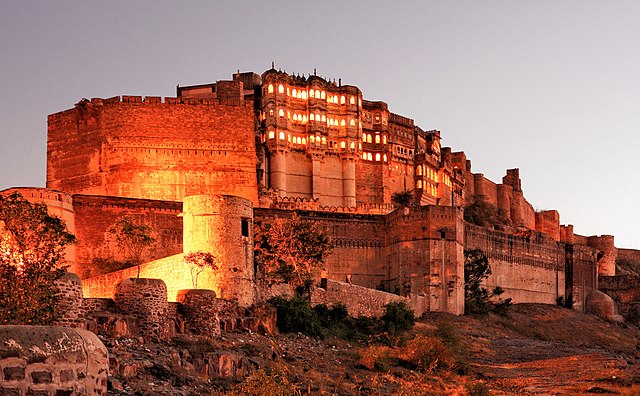
Mehrangarh Fort is the largest fort in India. The fort is located on a hilltop around 122 meters above the surrounding plain, it is spread over an area of 1,200 acres (486 hectares) in Jodhpur, Rajasthan.
The fort was constructed by Rao Jodha in 1459, the chief of the Rathore clan, and is credited with the origin of Jodhpur in India.
The Mehrangarh Fort was named Mehrangarh, meaning ‘fort of the sun’ – a reference to the clan’s mythical descent from the sun god Surya.
Read More: Taj Mahal – The Symbol of Love – Shah Jahan – Mumtaz Mahal
15. What is the Largest Museum in India?
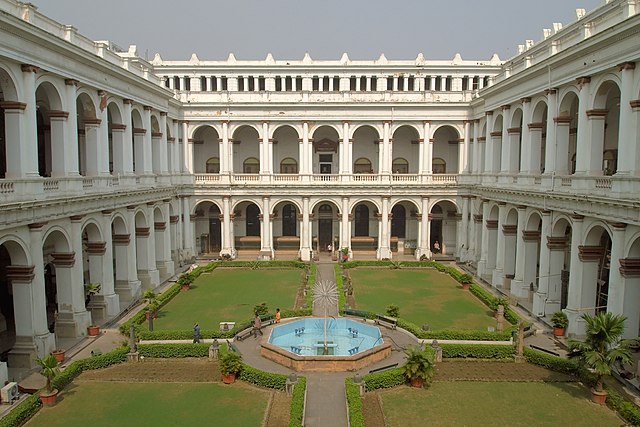
The Indian Museum in Central Kolkata, West Bengal is the largest Museum in India.
The Museum is also referred to as the Imperial Museum at Calcutta in colonial-era texts.
The Indian Museum is the ninth oldest museum in the world and the oldest and largest museum in India.
It has rare collections of antiques, armour and ornaments, fossils, skeletons, mummies, and Mughal paintings.
It was founded by the Asiatic Society of Bengal in Kolkata, India in 1814.
Read More: 15 Must-Visit Historical Places in India
Longest in India
1. Which is the Longest Railway Tunnel in India?
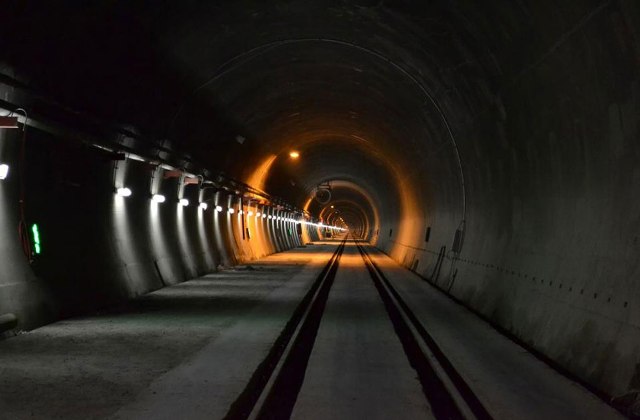
Pir Panjal Railway Tunnel is the longest railway in India. The length of the tunnel is 11.215 km between Quazigund and Banihal in Jammu and Kashmir.
It is a part of the Jammu–Baramulla railway line.
The 11.55 km long rail tunnel number 12 is under construction between Senapati and Imphal West districts on Jiribam–Imphal railway line.
Once completed it will surpass Pir Panjal Railway Tunnel and will become India’s Longest Railway Tunnel.
Although Indian Railway has plans to construct the Patalpani rail tunnel in Madhya Pradesh.
It is expected to be complete by 2025, this tunnel will become India’s longest railway tunnel with a whooping 49 km in length.
2. Which is the Longest Railway Bridge in India?
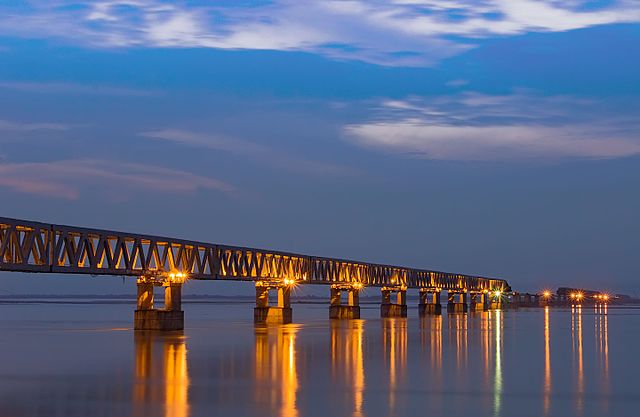
The Bogibeel Bridge is the Longest Railway Bridge in India. It is a combined constructed road and rail bridge over the Brahmaputra River.
It is Asia’s second-longest rail-cum-road bridge and has a serviceable period of around 120 years.
The Bogibeel Bridge has a length of 4.94 kilometres over the Brahmaputra River. The construction of India’s longest rail-cum-road started in the year 2002 and took a total of 200 months to complete.
It is located in Assam between Dhemaji district and Dibrugarh district.
The bridge was inaugurated by Prime Minister Narendra Modi on 25 December 2018 on the occasion of Good Governance Day.
The Bogibeel Bridge is India’s first bridge to have fully welded steel-concrete support beams and can withstand earthquakes of magnitudes up to 7 on the Richter scale.
The bridge was constructed by a consortium of construction companies headed by Hindustan Construction Company.
The Bogibeel Bridge has a double rail line on the lower deck and a three-lane road on the upper deck.
The Vembanad Rail Bridge is the second-longest railway bridge in India. It has a total length of 4,620 meters.
It connects rail lines between Edappally and Vallarpadam in Kochi, Kerala, and is dedicatedly used for freight services.
Read More: Longest Railway Bridge in India – Bogibeel Bridge
3. Which is the Longest Railway Platform in India?
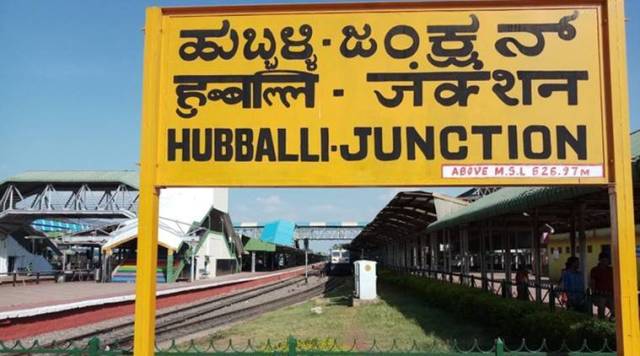
Hubbali Junction is the longest railway platform in India with a length of 1,400 meters (4,600 ft). It is also the world’s longest railway station platform.
Previously Gorakhpur railway station was the longest railway platform in India. It has a length of 1366 meters.
It remained the longest railway platform in the world from October 2013 until surpassed by the Hubbali Junction Railway Platform.
4. Which is the Longest Dam in India?
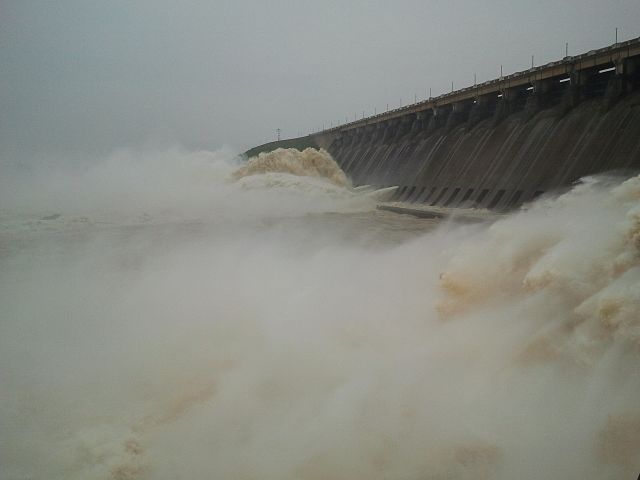
Hirakud Dam is the longest dam in India. It is located in the state of Orissa and has a total length of 25.79 km.
Situated on the river Mahanadi about 15 km from Sambalpur, Odisha. It also features in the list of the longest dams in the world.
It is one of the first major multipurpose river valley projects that started after India’s independence.
Sir Hawthorne Lewis, the Governor of Odisha laid the foundation stone of the Hirakud Dam on 15 March 1946.
Pandit Jawaharlal Nehru laid the first batch of concrete on 12 April 1948.
The dam was completed in 1953 and was formally inaugurated by Prime Minister Jawaharlal Nehru on 13 January 1957. Power generation along with agricultural irrigation started in 1956, achieving full potential in 1966
Hirakud Dam has been declared a Ramsar site in August 2022.
Read More: Ganga of South India- The Dakshin Ganga | The Godavari River
5. Which is Longest Traveling Train in India?
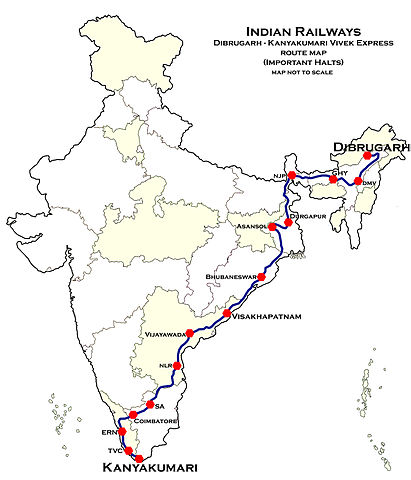
Vivek Express from Dibrugarh in Assam to Kanyakumari in Tamil Nadu is the longest Traveling Train in India.
The train route between Dibrugarh to Kanyakumari is the longest train route in the Indian Railways network.
It covers a total distance of 4218.6 km traveling through 8 states with 58 intermediate stoppages. And takes almost 74 hours and 35 minutes to reach its destination.
It is the 24th-longest train service in the world.
Vivek Express are four pairs of Express Trains on the Indian Railways network. These trains were started to commemorate the 150th birth anniversary of Swami Vivekananda.
These trains were announced by the then Railway Minister Mamata Banerjee in the Railway Budget of 2011-12.
6. What is the Longest Road Tunnel in India?

Chenani Nashri Tunnel is the longest road tunnel in India. It is also known as Dr. Syama Prasad Mookerjee Tunnel situated on NH 44 in Jammu and Kashmir.
The construction of the tunnel started in 2011 and was completed in 2017, it has a length of 9.028 km.
It is also Asia’s longest bi-directional highway tunnel.
The Chenani Nashri Tunnel reduces the distance between Jammu and Srinagar by 30 km and travel time by two hours. It is India’s first tunnel with a fully integrated tunnel control system.
It bypasses places like Kud, Patnitop, and Batote which are snowfall and avalanche-prone areas in winter.
These areas used to obstruct NH 44 and used to be the cause of long queues of vehicles for days together.
Atal Tunnel also known as Rohtang Tunnel is the longest highway single-tube tunnel above 10,000 feet (3,048 m) in the world with a length of 9.02 Km
It has officially been certified by the World Book of Records, as the ‘World’s Longest Highway Tunnel above 10,000 Feet’, during a landmark ceremony on 09 February 2022, in New Delhi
It is built under the Rohtang Pass in the eastern Pir Panjal range of the Himalayas on the Leh-Manali Highway in Himachal Pradesh.
Read More: Facts about the Chenani Nashri Tunnel
7. Which is the Longest Road Bridge in India?
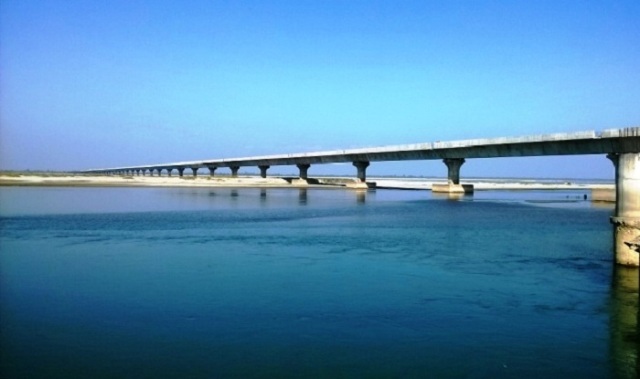
The Bhupen Hazarika Setu is the longest road bridge above water in India. Located in Assam it is commonly known as Dhola Sadiya Bridge.
The bridge has a total length of 9.15 km and connects the northeast states of Assam and Arunachal Pradesh.
The Bhupen Hazarika Setu is the first permanent road connection between northern Assam and eastern Arunachal Pradesh. It is built over the Lohit River, a tributary of the river Brahmaputra.
The Dibang River Bridge is the second road longest bridge above water in India and was completed in 2018.
It connects Dambuk and Roing in the eastern part of Arunachal Pradesh and has a total length of 6.2 km.
However, the Kacchi Dargah–Bidupur Bridge is under construction and has an expected length of 9.76 km and will surpass the Bhupen Hazarika Setu as the longest road bridge in India over water.
The bridge will connect Kacchi Dargah in Patna and Bidupur in Hajipur in Bihar and is estimated to be complete by July 2023.
8. Which is the Longest Expressway in India?
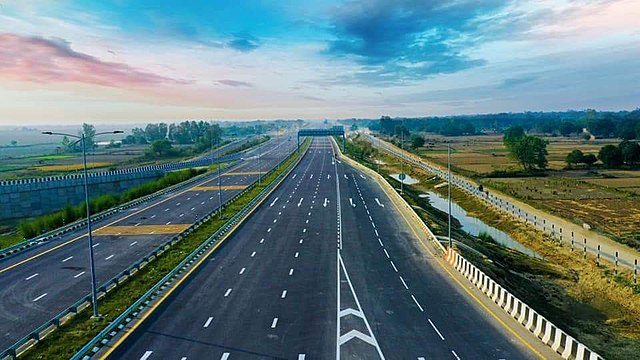
The Purvanchal Expressway is the longest Expressway in India. Developed by Uttar Pradesh Expressways Industrial Development Authority (UPEIDA).
The Purvanchal expressway connects Chand Saray village near Gosainganj in Lucknow district with Haydaria village on NH-31 in Ghazipur district and is 6-lane wide (expandable to 8).
It has a 3.2 km long airstrip at Akhalkiri Karwat village in Sultanpur district for emergency landing of aircraft. 6-lane wide (expandable to 8)
Agra Lucknow Expressway is the second longest expressway in India. It has a length of 302.2 km and connects the cities of Agra and Lucknow.
The Delhi–Meerut Expressway with 14 lanes is the widest expressway in India.
Under construction Delhi–Mumbai Expressway which will connect India’s national capital New Delhi with its financial capital Mumbai will surpass the Purvanchal Expressway once completed.
The Delhi–Mumbai Expressway has a length of 1350 km and is 8-lane wide (expandable to 12-lane) and is expected to be complete by March 2023.
It will become India’s longest and busiest expressway.
9. Which is the Longest National Highway in India?
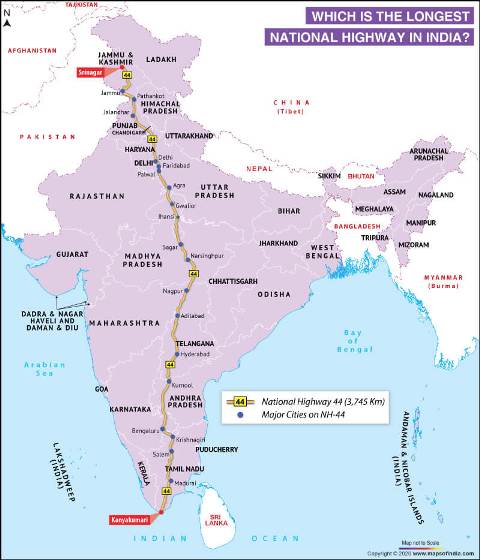
National Highway 44 is the longest national highway in India. It has a total length of 3745 km, starting from Srinagar in the north and ending in Kanyakumari in the south.
National Highway 44 (NH 44) was previously known as National Highway 7.
The NH44 come into being by merging seven major national highways of old numbers that include NH 1A, NH 1, NH 2, NH 3, NH 75, NH 26, and NH 7.
10. Which is the Longest Wall in India?
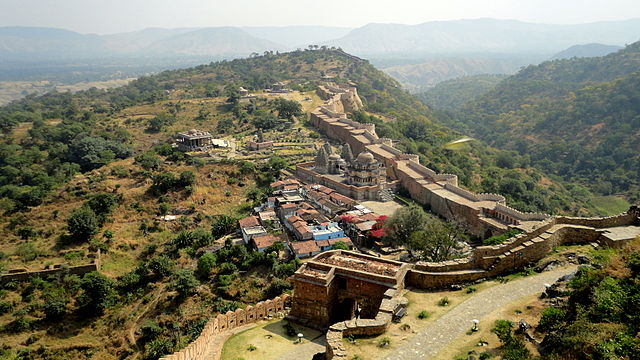
The Great Wall of Kumbhalgarh Fort in Rajasthan is the longest wall in India. It is also known as the Great wall of India and second longest wall in the world.
The Kumbhalgarh fort was built by Rana Kumbha in the 15th century and the fort is among the largest fort complexes in the world. It is spread to an area of 662 acres (268 ha)
The chief architect who built this fort was Mandan, who documented his style of work in his text, Rajvallabh.
The Kumbhalgarh fort is built on a hilltop at a height of 1,100 m on the westerly range of Aravalli Hills.
It is about 48 km from Rajsamand city in Rajasthan and about 84 km from Udaipur.
The fort has a perimeter of walls that extends up to 36 km and the frontal walls are fifteen feet thick.
The Kumbhalgarh fort has seven fortified gateways. There are over 70 temples within the fort, both Jain and Hindu Temples.
In 2013 it was declared a UNESCO World Heritage Site under the group Hill Forts of Rajasthan.
Read More: Qutub Minar – Tallest Brick Minar in the World
11. Which one is the Longest Beach in India?

Marina Beach is the longest beach in India. Situated in Chennai it has a length of 13 km which includes 6 km of the seafront.
It is the longest natural urban beach in India and the second longest in the world after Cox’s Bazar Beach in Bangladesh.
The beach runs from near Fort St. George in the north to Foreshore Estate in the south, Chennai along the Bay of Bengal.
It was renovated by Governor Mountstuart Elphinstone Grant Duff in the 1880s.
12. Where is the Longest Cave in India?
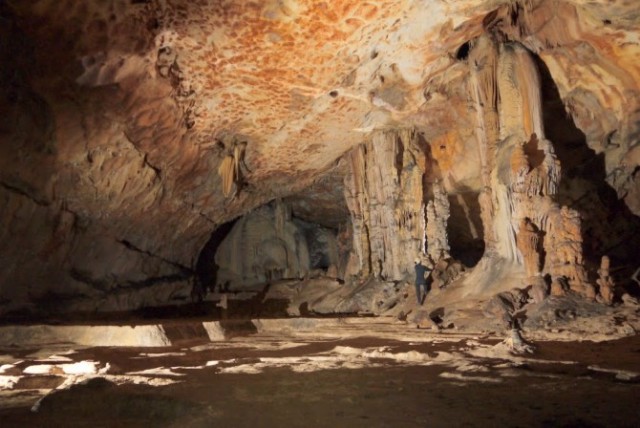
Krem Liat Prah Meghalaya is the longest natural cave in India.
The Krem Liat Prah in the Jaintia Hills is 30,957 m (101,600 ft) long. The word “Krem” means Cave in the local Khasi language.
The Caves of Meghalaya comprise a large number of caves in the Jaintia, Khasi Hills, and Garo Hills districts in Meghalaya.
These Caves in Meghalaya are not only the longest in India but also among the longest caves in the world.
Out of the top ten longest caves in India, the first nine caves are in Meghalaya and the tenth is in Mizoram.
There is an annual caving expedition organized by Meghalaya Adventurers Association (MAA) and is known as the “Caving in the Abode of the Clouds Project”.
13. Which is the Longest Canal in India?
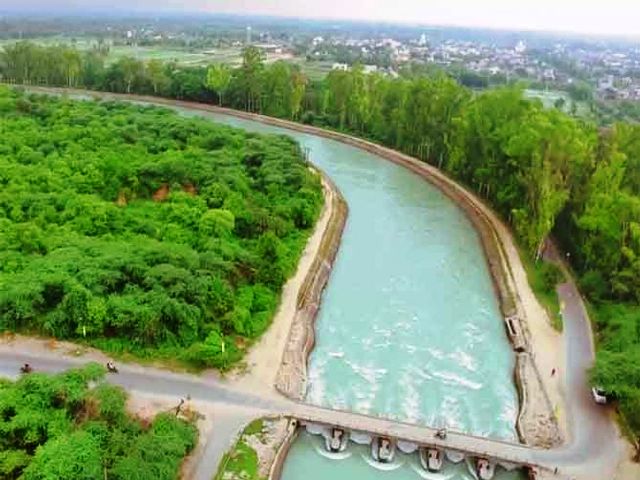
The Indira Gandhi Canal is the longest canal in India and has a total length of 605 km.
It starts at the Harike Barrage in Punjab and ends in irrigation facilities in the Thar Desert in northwest Rajasthan.
The canal was renamed the Indira Gandhi Canal on 2 November 1984 following the assassination of Prime Minister Indira Gandhi. Earlier it was known as the Rajasthan Canal.
After the construction of the Indira Gandhi Canal, irrigation facilities were available over an area of 6,770 km2 (1,670,000 acres) in Jaisalmer district and 37 km2 (9,100 acres) in Barmer district.
14. Which is the Longest River in India?
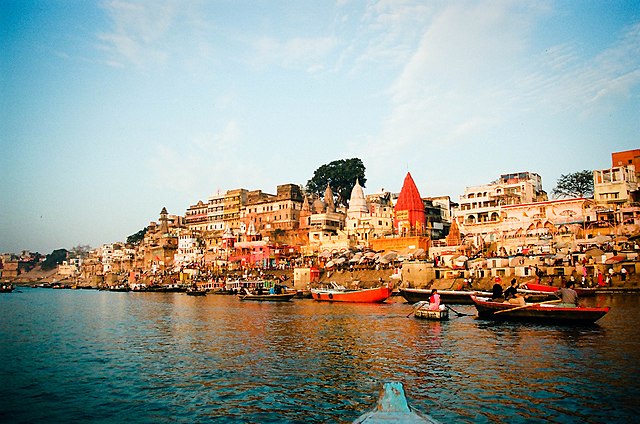
The Ganges also known as the Ganga is the longest river in India. Originating in the Himalayas from the Gangotri glacier it is the most sacred river for Hindus.
The Ganges is the longest river in India and also the largest river in India followed by the Godavari.
Originating from the Gangotri glacier, the main stem of the Ganges begins at Devprayag at the confluence of the Alaknanda and the Bhagirathi.
The Ganga is a transboundary river that flows through India and Bangladesh. Ganga is called the Padma in Bangladesh.
It is joined by Jamuna, the lower stream of the Brahmaputra, and eventually the Meghna for the major estuary of the Ganges Delta. And then it discharges into the Bay of Bengal.
The Ganga has a length of 2525 km and it flows through the states of Uttarakhand, Uttar Pradesh, Bihar, and West Bengal.
Read More:
15. Which State has the Longest Coastline in India?
Gujarat state has the longest coastline in India. It has a coastline of 1214.7 km followed by Andhra Pradesh with 973.7 km.
Andaman and Nicobar Islands have the longest coastline in India among the Indian Islands.
Indian Union Territory of Damn and Diu has the shortest coastline of 42.5 km.
India has a coastline of about 7,516.6 km bordering the mainland and the islands with the Bay of Bengal in the East, the Indian Ocean in the South, and the Arabian Sea in the West
Length of the Coastline of India
| State/UT | Length (in Km) |
| Gujarat | 1214.7 |
| Andhra Pradesh | 973.7 |
| Tamil Nadu | 906.9 |
| Maharashtra | 652.6 |
| Kerala | 569.7 |
| Odisha | 476.4 |
| Karnataka | 280 |
| West Bengal | 157.5 |
| Goa | 101 |
| Andaman & Nicobar Islands | 1962 |
| Lakshadweep | 132 |
| Puducherry | 47.6 |
| Daman & Diu | 42.5 |
Highest in India
1. Which is the Highest Lake in India?
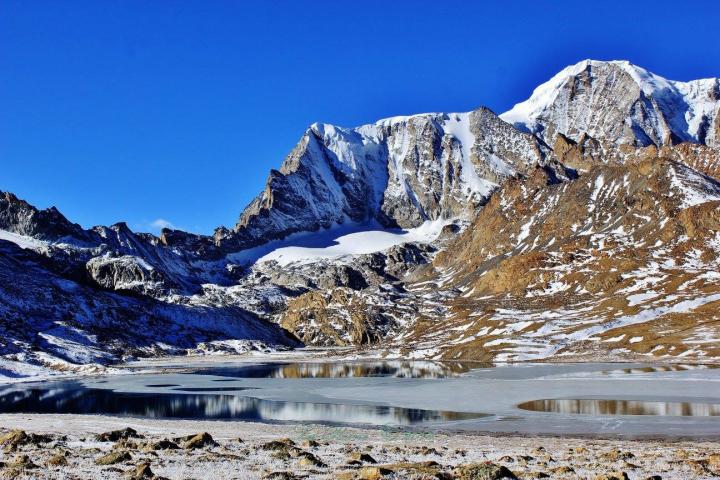
Tso Lhamo Lake or Cholamu lake is the highest lake in India. Located in Sikkim it is at an altitude of 6,200 m (20,300 ft)
It is one of the highest lakes in the world, situated just about 4 km southwest of the international border with China in North Sikkim
The Tso Lhamo Lake is a fresh-water glacial lake located northeast of the Kangchenjunga range.
The source of the lake is the water from the Zemu glacier, Kangtse glacier (or Pauhunri glacier) and it is the source of the Teesta River.
The Gurudongmar Lake is the second highest lake in India located at a height of 5,430 m (17,800 ft). The lake lies just 5 km to the west of the Tso Lhamo Lake.
It is also a fresh-water glacial lake that along with the Tso Lahmu forms the source of the Teesta River.
The Gurudongmar Lake remains completely frozen in the winter months, from November to Mid-May.
The lake is considered sacred by Buddhists, Sikhs, and Hindus.
It is named after Guru Padmasambhava also known as Guru Rinpoche the founder of Tibetan Buddhism.
Read More: Golden Temple, Amritsar – Four Doors To Heaven
2. Which is the Highest Waterfall in India?
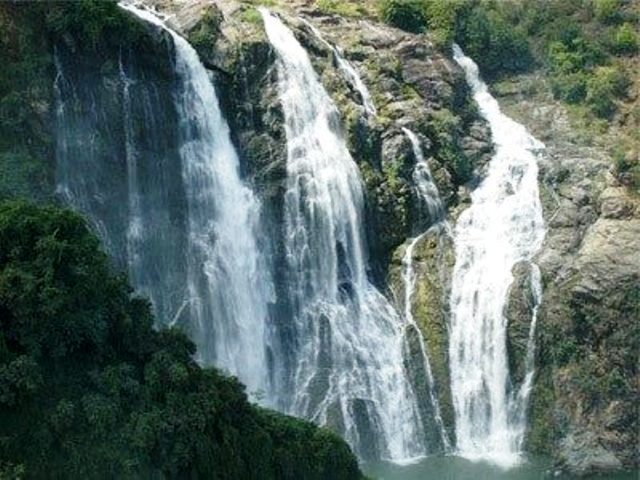
Kunchikal Falls is the Highest Waterfall in India. The waterfall has a height of 455 meters (1493 ft) and is located in Shimoga District, Karnataka.
It is situated inside the Agumbe rainforest and is formed by the Varahi River.
Barehipani Falls stands in the second position as the Highest Waterfall in India followed by Nohkalikai Falls.
Barehipani Falls is situated in the Mayurbhanj district, Odisha, and has a height of 399 meters (1,309 ft).
Nohkalikai Falls is situated in the East Khasi Hills district of Meghalaya and has a height of 340m (1115 feet). It is the tallest plunge waterfall in India.
3. What is the Highest Mountain in India?
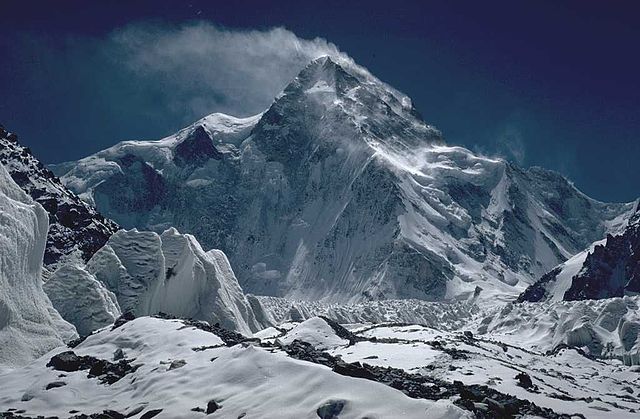
K2 or Mount Godwin-Austen is the Highest Mountain in India. It is also known by the nicknames The King of Mountains and The Mountaineers’ Mountain.
K2 has a height of 8,611 meters (28,251 ft) above sea level and is the second-highest mountain on Earth, after Mount Everest (8,848 m)
It lies in the Karakoram range partially in the Gilgit-Baltistan (Pakistan-occupied Kashmir) region and partially in a China-administered territory of India
Kanchenjungha is the second highest mountain and highest peak in India. It is located at the border of Sikkim and Nepal.
It is the third highest mountain in the world.
Kangchenjunga, also spelled Kanchenjunga and Khangchendzonga has a height of 8598m (28,169ft) above sea level.
It was assumed to be the highest mountain in the world until 1852.
But calculations and measurements by the Great Trigonometrical Survey of India in 1849 showed that Mount Everest, known as Peak XV at the time, is actually higher.
In 1856 it was officially announced that Kangchenjunga was the third highest mountain
Khangchendzonga National Park was declared a UNESCO World Heritage Site in 2016
4. Which is the Highest Dam in India?

The Tehri Dam is the highest Dam in India. It is located in Tehri Garhwal district in the state of Uttarakhand.
The dam is situated on the river Bhagirathi and has a height of 260.5 meters. It stands 12th in the list of highest dams in the world.
The Tehri Dam is a multi-purpose rock and earth-fill embankment dam with a total planned installed capacity of 2400 MW.
It is the biggest Hydroelectric power plant in India.
Read More: Cleanest River in India – The Umngot River
5. Which is the Highest Gateway in India?
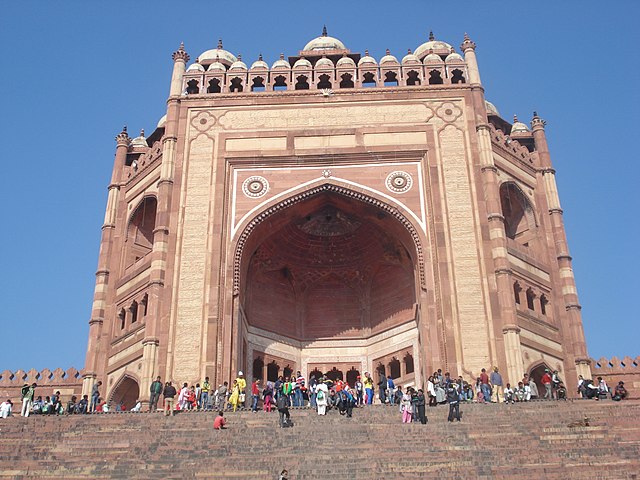
Buland Darwaza (Door of Victory) is located at Fatehpur Sikri in Agra and is the Highest Gateway in India.
It was built by Mughal Emperor Akbar to celebrate his victory over Gujarat. It displays the elegance, sophistication, and heights of technology in Akbar’s empire.
Buland Darwaza is the main entrance to the Jama Masjid at Fatehpur Sikri, which is 43 km from Agra.
It was not a part of the original design of the Jama Masjid but it was erected to celebrate his conquest of Gujarat. Verses from the Quran have been carved in the Naskh (script) along the top.
6. Which is the Highest Speed Train in India?
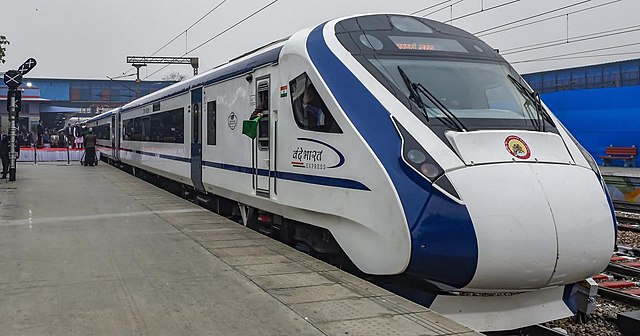
The Gatimaan Express is currently the highest-speed train in India and has a top speed of 160 km/h.
The fastest train as of 2022 in India is the Vande Bharat Express which has a top speed of 180 km/h (110 mph). But the Gatimaan Express is the fastest operating train with a top operating speed of 160 km/h (99 mph).
The first high-speed railway corridor of length 508 km is currently under construction between Mumbai and Ahmedabad. It will have a top operational speed of 320 km/h (200 mph).
The Indian Railways is currently improving their existing conventional railway lines to handle speeds up to 180 km/h (110 mph).
7. Which is Highest Railway Bridge in India?

The Chenab Rail Bridge is the highest railway bridge in India. It is built over the Chenab river in the Reasi district of Jammu and Kashmir.
The rail bridge has a height of 359 m (1,178 ft) and is also the Highest Rail Bridge in the World.
The Chenab Rail Bridge connects Bakkal and Kauri, Reasi. The rail bridge is a steel and concrete arch bridge.
The bridge was fully completed and was inaugurated in August 2022. It is expected to open to rail traffic in December 2022.
8. Which is the Highest Railway Station in India?

The Ghum Railway Station of the Darjeeling Himalayan Railways is the highest railway station in India.
The railway station is situated at an altitude of 2,258 meters (7,407 ft).
The construction of the Darjeeling Himalayan Railway started in 1879 and the railway track reached Ghum on 4 April 1881.
The journey from Kolkata to Darjeeling used to take 5–6 days until 1878, using steam-engine-pulled trains.
Siliguri was put on the railway map of India in 1878 and shortening the journey to two days.
9. Which is the highest motorable Road in India?
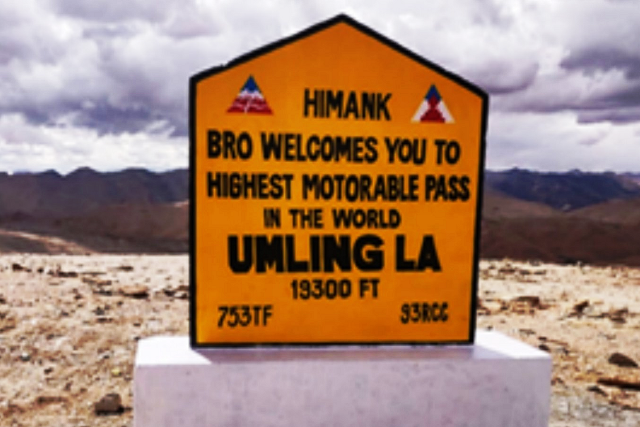
The Umling La Pass in Ladakh is the highest motorable road in India.
At an elevation of 5,798.251 m (19300 ft), the Umling La Pass is not only the highest motorable road in India but also in the world.
The Umling La is a traversed road between Chisumle and Demchok and has overtaken Dungri La – 18,399 ft and Khardung La Pass -17,582 ft.
The road was constructed by the Border Roads Organization of India (BRO).
Himank or Project HIMANK is a project of the Border Roads Organisation (BRO) which is responsible for the construction of Umling La.
It is also responsible for some of the other world’s highest motorable roads across the Khardung La, Tanglang La, and Chang La passes.
Himank is responsible for constructing and maintaining motorable roads in Ladakh, along the Line of Actual Control.
Himank makes sure the smooth access to military sensitive areas including the world’s highest battleground at the Siachen Glacier and Pangong Tso Lake along the Indo-China border.
Most of its manual labourers are from Jharkhand state, not Ladakh. They are nicknamed Dumkas.
Between 1987 and 2002, at least 124 Himank personnel were killed while on duty in Ladakh, including five officers.
Read
10. Which is the Highest airport in India?
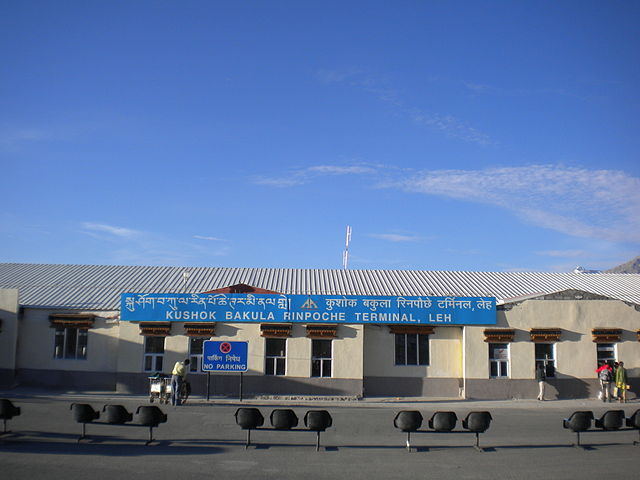
Kushok Bakula Rimpochee Airport is the highest airport in India. The airport is located in Leh at a height of 3,256 m (10,682 ft) above mean sea level.
The airport is named after Ngawang Lobzang Thupstan Chognor commonly known as 19th Kushok Bakula Rinpoche.
He was an Indian statesman, and monk, whose Spituk Monastery is in the direct vicinity of the airfield. He also served as India’s ambassador to Mongolia.
11. Which is the Highest Battle Field in India?
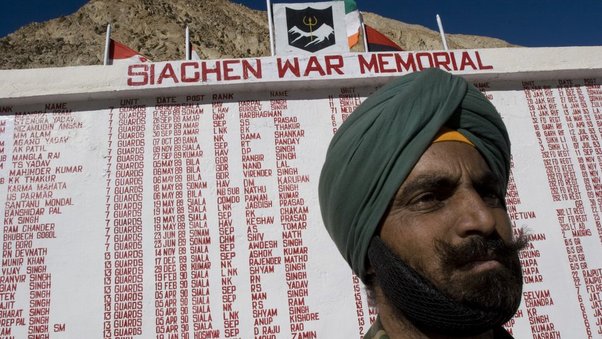
Siachen Glacier is the highest battlefield in India.
Siachen is the Highest Battleground on earth, a place where even eagles do not dare to fly, our soldiers live there for months together guarding the motherland. The place where more soldiers die because of adverse climatic conditions rather than bullets and war.
The Siachen Glacier is located in the eastern Karakoram range in the Himalayas. It is the longest glacier in the Karakoram and is almost 76Km long. It is the second-longest in the world’s non-polar areas.
Siachen Glacier is at an altitude of 5,753 m above sea level.
Siachen is under Indian administration since 1984 with all the major passes also under its control. Pakistan controls the region west of Saltoro Ridge, far away from the glacier.
Read More: Siachen Glacier – The Highest Battle Ground on Earth
12. Which place gets the Highest Rainfall in India?
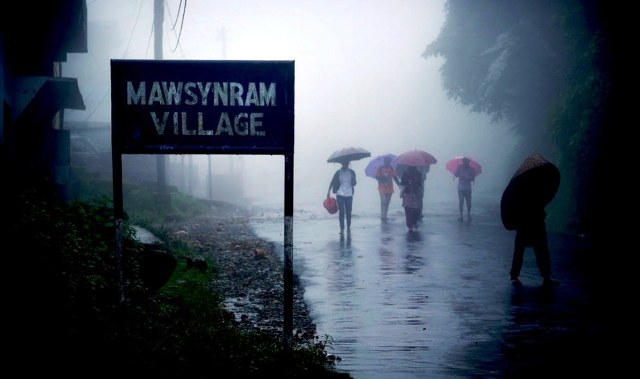
Mawsynram is the place with the highest rainfall in India. It is a small town in the East Khasi Hills district of Meghalaya, the northeastern part of India.
It is reportedly the wettest place on Earth, with an average annual rainfall of 11,872 millimeters.
Mawsynram received 26,000 millimeters (1,000 in) of rainfall in 1985 which is a world record and recorded in the Guinness Book of World Records.
Cherrapunji had occupied the position of the highest rainfall in India and the world also for a significant amount of time. But recent observations have revealed that it is Mawsynram that receives the maximum amount of annual rainfall.
Mawsynram is just located 15 km west of Cherrapunji.

